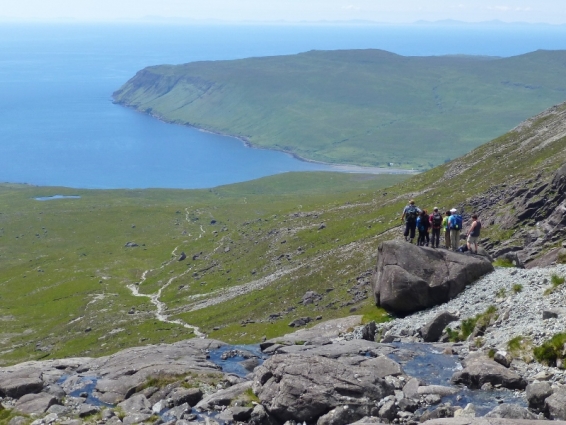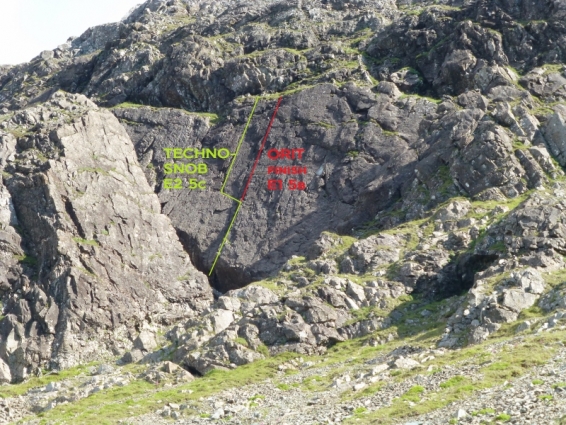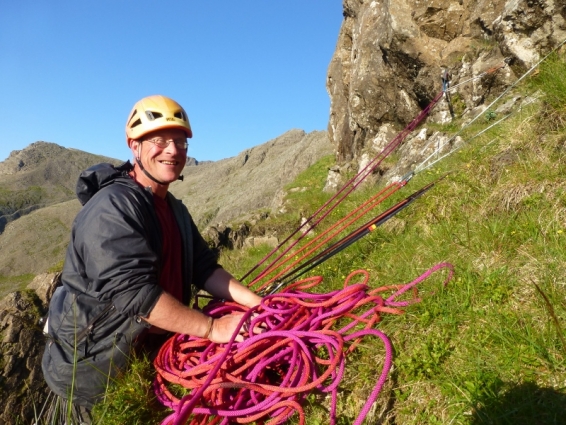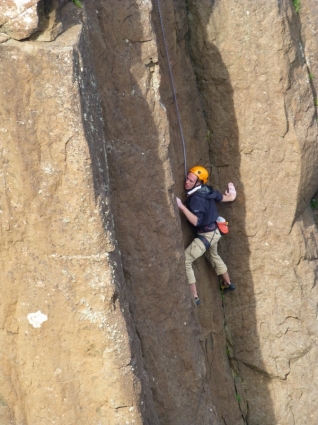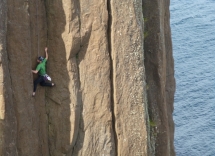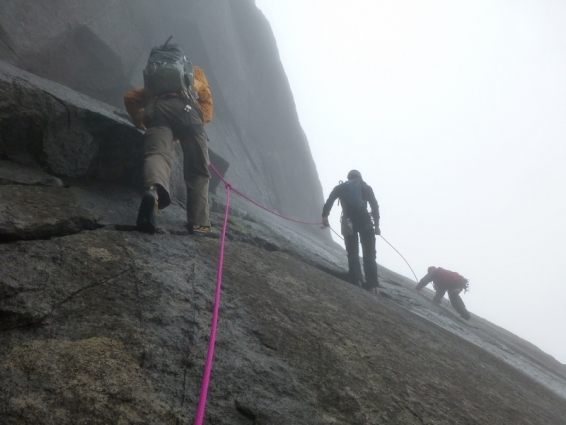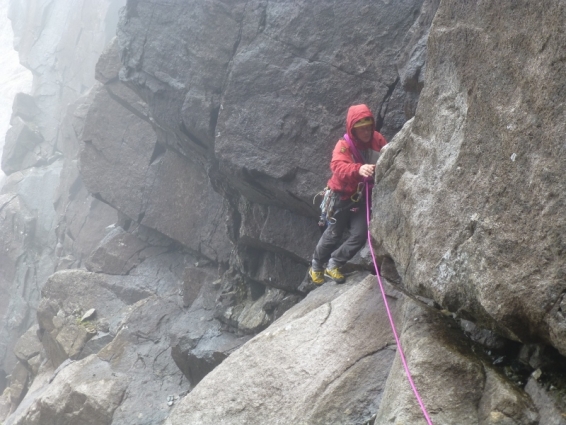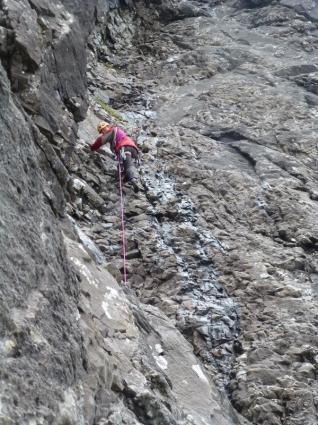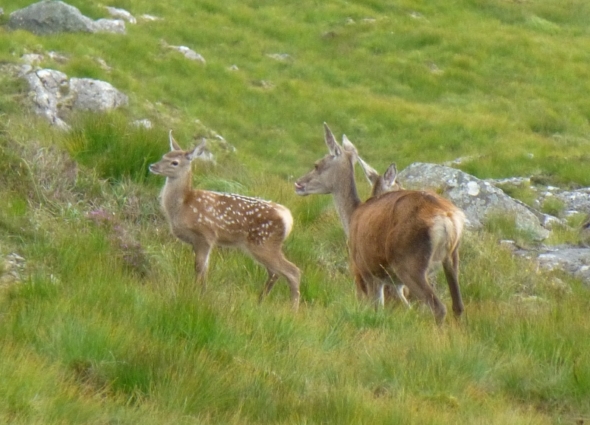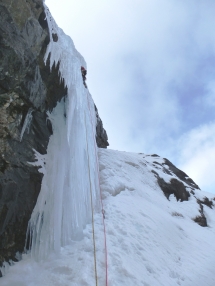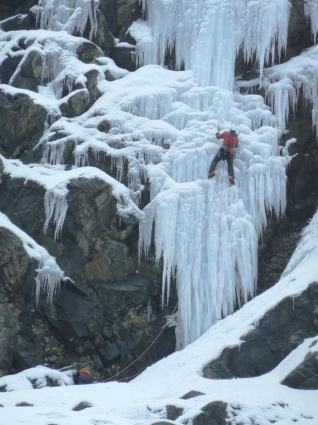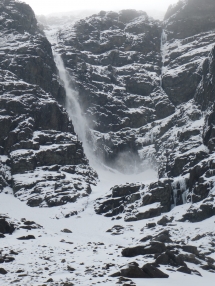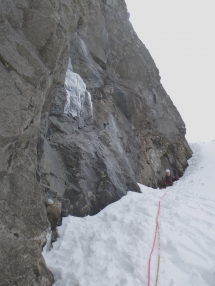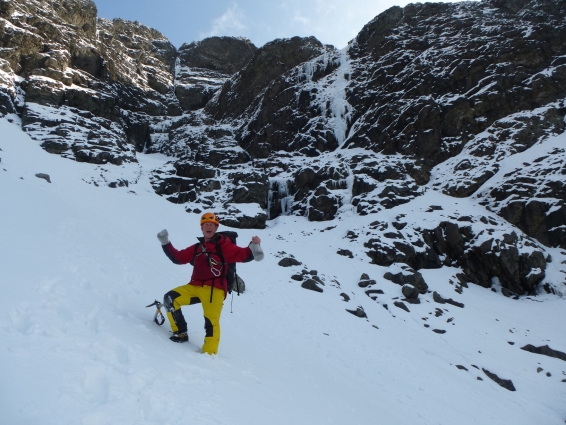Graupeling with Gully A, December 8th.
Great outing on Monday with Iain & Jamie on Sgurr Thearlaich again, this time on Gully A. Higher up we were defeated by mad quantities of graupel (hailstones) appearing from nowhere but the first pitch was absolute quality.
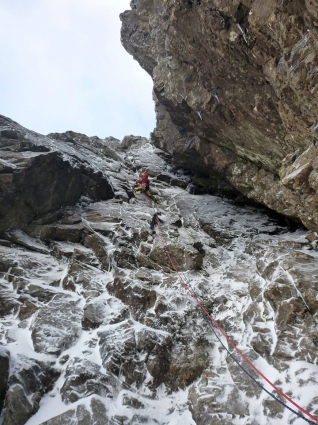 Bridging delicately up the groove; the inside of the chimney looked very involved with a nasty chockstone to finish.
Bridging delicately up the groove; the inside of the chimney looked very involved with a nasty chockstone to finish.
The first winter ascent was solo by Roger O’Donovan in April 1970 (after soloing the 900 ft route Jeffrey’s Dyke in 1.5hrs). He recorded 3 short ice pitches and gave it grade III. He was head instructor at Glenmore Lodge and, significantly, one of the first people using drooped pick axes and front pointing on crampons. This technique had only begun to be experimented with during the winter before.
Uisdean & Callum probably made the 2nd ascent in the very good conditions in 2013 and reported it as considerably harder than grade III.
Yesterday, in pure mixed conditions (glazed & powder with no build-up of snow) the first pitch gave 30m of well protected crack climbing with some funky moves and probably modern grade V,6. It was so good I’m really looking forward to going back to get the route finished.
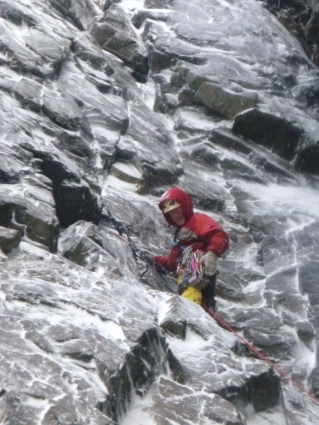 Placing great protection in the crack before setting off up the steepest section.
Placing great protection in the crack before setting off up the steepest section.
Let the good times rock….. new climb, Kilt & Girdle Traverse
A great few days of rock climbing recently with my good friend Lucy back again to add any keenness I may be lacking!
Thursday started with a sunny walk up into Coire Lagan with the students of Landmark College.
After cooling the feet back in Loch Brittle we set back off up and one of the hottest walk-ins that I can ever remember. The target was a direct finish to Techno Snob– that Malcy & I climbed in 2012.
All the effort was worthwhile as we were rewarded with an evening of climbing on glorious clean hot rock. The Oldest Raver on Skye finish was even good enough to be considerably easier (E1 5b) than the parent route with the crux being the stiff rockover move off the ground. A word of warning to aspirants is that the best gear on this move is very high, too high for me, so Lucy stood on my shoulders to place it!
On Friday three Mikes and a Lucy headed to Kilt rock and a race to climb as much as possible before the rain arrived. Clandestine (VS) and Secret Service (HVS) were topped off with ascents of the uber classic Grey Panther. With a full ropelength of superb climbing on a plumb vertical fault this is a strong contender for the best E1 in the UK.
Saturday was as wet as predicted but Sunday was forecast as wall to wall sunshine. The 2 Mikes had been reading up on the Girdle Traverse of Sron na Ciche in the guidebook and Lucy and I agreed it would make a great team climb. 3 years ago we’d taken 5 hours in perfect conditions but JEB Wright, a guide back in the 1920’s recorded climbing it with parties of 4, 5 and 6 in all sorts of conditions and never in more than 6 hours.
The clear tops sank back into the mist as we arrived and a cold wind nipped at the fingers as we geared up. 2nd time around and with a quality team we made good progress to the Serpentine Chimney. Lucy & I felt we had cheated last time by abseiling the downclimbs but our attempt to mirror them failed at the first hurdle with a long damp move at the foot of the climb.
Things warmed up after Eastern Gully as we sped past a continuous series of old classic routes; the Cioch, down to the Terrace and Doom Walls, another abseil, over the Hexagon Block and across Amphitheatre Arete. Gaining entry to Trap Face Route once again proved awkward and needed a few runners to keep us safe before following the trap right out to overlook Western Gully and some welcome sunshine and lunch.
We’d made it in under 4 hours this time and Mr JEB Wright now seems a little less superhuman. His first effort took only 2.5 hours though so we’ve a way to go to still!
Amazing Ice- The Smear 12th April 2013
We managed a perfect finish to a brilliant long winter on Friday by climbing The Smear, the longest steep icicle in the Cuillin and probably only the 2nd ascent ever.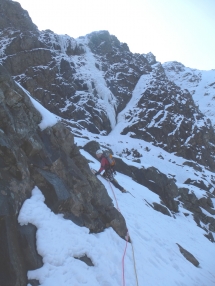
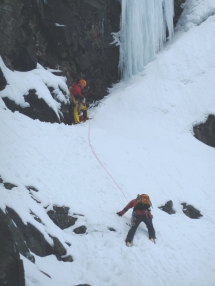 The ice was utterly perfect from bottom to top but still needed a fantastic explosion of effort from Andy to lead the very steep start.
The ice was utterly perfect from bottom to top but still needed a fantastic explosion of effort from Andy to lead the very steep start.
The climb was originally given grade V when V was the highest Scottish grade but we both agreed that it warranted grade VI by modern standards.
Two 45m pitches seemed to pass almost too quickly but the grins said it all for the rest of the day.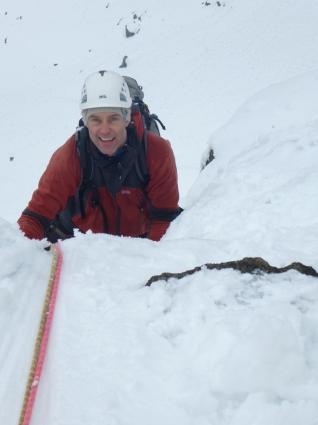 Smiles of success
Smiles of success
Things weren’t all glorious; a load of fresh overnight snow was sloofing off regularly from left right & centre. The “walk off” down the Upper Rake involved descending dangerous quantities of deep fresh snow lying on a very steeply banked terrace and probably more complex rope-work than the climb itself!
I first went to the foot of The Smear in 1994 but I’ve never seen it anywhere near climbable until this last week. Andy is sailing back to Australia this summer so such a notable bit of Scottish ice is a great Swansong. Looking forward to borrowing his tools & screws for the next few winters:)
The Smear was first climbed by Jim Duff & Doug Scott back in 1979.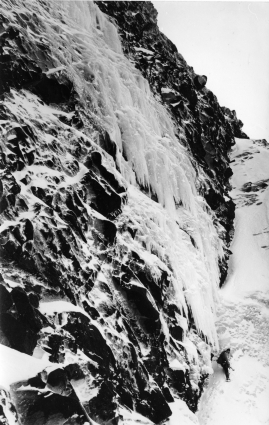
Doug Scott below The Smear in 1979
To my knowledge the route hasn’t received a second ascent since; zooming in on Ginger Cain’s photo it looks like Doug Scott had been on the Red Bull to get up the first 10m as the icicle fringe doesn’t even appear to be touching down.
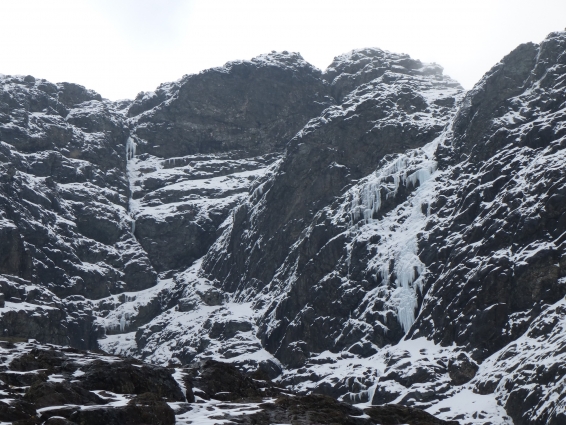 Icicle Factory (on the left) looked close but not complete in the lower sections
Icicle Factory (on the left) looked close but not complete in the lower sections
The man who met Norman Collie
Skye-born Munro-bagger’s link with Cuillin history.
In May this year our Skye Guide Malcom Airey guided 79 year old Alasdair MacPherson, along with his daughter Fiona, on an ascent of the Inaccessible Pinnacle. Malcolm was amazed to hear that Alasdair had once met the great Cuillin pioneer Professor J. Norman Collie.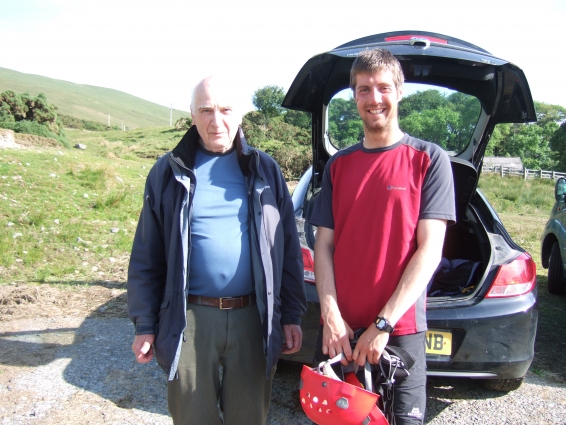
Alasdair was born in Kraiknish by Eynort in 1932, the 2nd of 7 sons born to Duncan & Margaret MacPherson. In 1938, on a return journey from an auntie’s house in the Braes, he was taken to the Sligachan Hotel. It was here that Norman Collie was pointed out to him in the hotel lounge. Although his own encounter was very limited it seems that Collie was well known amongst the local crofters both through the hotel and accompanying him on the hill.
Collie had discovered the joys of climbing on Skye in 1887 and went on to pioneer many climbs throughout the world but made no secret that his heart lay in the Cuillin. He had retired to Skye shortly before Alasdair’s encounter with him and lived at the hotel for nearly a decade looking out on the peaks he knew so well. He died in 1942 and was laid to rest in a grave adjoining that of his Skye Guide and good friend John Mackenzie for whom he had so much admiration.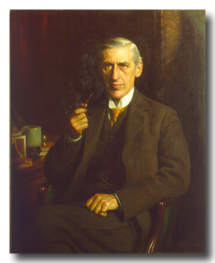
Alasdair himself left the island at the age of 18, qualified as a veterinary surgeon at Glasgow University and is now retired and living in Stonehaven. Having climbed the hardest of all the Munros he now has only 34 peaks left to compleat his round.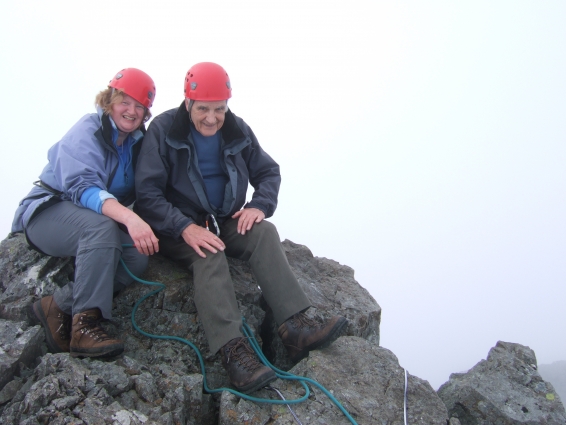
Incredible History
Writing the SMC guidebook has been a fascinating process aided mainly by the text produced by the research of Stuart Pedlar. Those who think history is boring should read on…
After Wednesday’s ascent of the outside variation to Shadbolt’s Chimney I struggled to find the description of the original summer ascent. I informed Martin, Pete & Francis that it had been done in 1932 and e-mailed Stuart for clues. Meantime Martin gave me the description-
Shadbolt’s Chimney: Shoot the Bolt VII, 7 ** A winter ascent of the outside of the chimney (avoiding the tunnelling through-route). A short awkward step led into the cavern. The 8 metre roof of the chimney gave a unique and brilliant pitch with sustained back and foot techniques leading to a heavily rimed exit squeeze.
F.Blunt, P.MacPherson, M.Moran 2nd Dec 2010
with the comments-
I’m amazed that the outside of the chimney was only VDiff – they were very brave in those days! They would have had no gear and the chimneying felt like VS, 4c to me. Maybe downgrade the winter ascent to VI, 7 and forget the name.
We had no idea about earlier ascents, so we were somewhat intimidated. Pete struggled quite a lot on the lead, and Francis looked suitably stressed seconding! Given that we cruised The Secret a week earlier I get more rather than less confused about gradings as the years go by.
SHADBOLT’S CHIMNEY IS THE OBVIOUS FAULT IN THE TOOTH
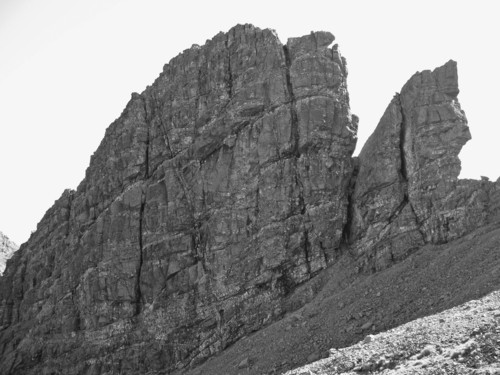
To cap it all Stuart has come back with the amazing full story from his book (that will be published sometime after the SMC book is printed)-
’Tarbuck later explained how he and Geoffrey Collin ‘climbed the Tooth by Naismith’s route. I moved to the opposite edge and looked down the north face, and was surprised to find that the upper half was sufficiently broken up to allow some good climbing.
There was not the slightest chance of making a complete descent, however, as the lower part of this face is composed of rotten rock which has weathered away, leaving the top overhanging the base. I climbed down as far as the overhang, where every possibility ceased. The position was thrilling, for the lower rocks cannot be seen, and nothing meets the eye till the upper scree of Coire a’ Bhasteir; even the assurance of a rope from above could not entirely alleviate the sensation.
Descent being out of the question, I traversed away to the left, and after a difficult corner found myself looking down into the outside cleft of the North Chimney, and as overhangs have no terrors in a chimney, it occurred to me that here might be a way down. I was now too far to the left to get full protection from my rope, so I traversed back and ascended the face. We moved over to a better position directly above the chimney. The chimney is not obvious from above, and it dies out on the face just short of the top, but the position can be got by moving towards the edge from the exit-hole of Shadbolt’s climb and keeping along the strata.
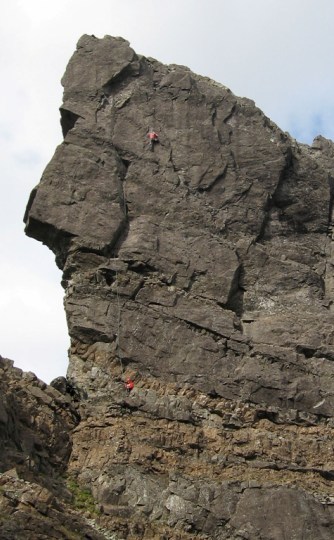
CAPTAIN PLANET E4, 6a on the opposite face of the Basteir Tooth.
I took my turn at holding the rope, whilst Collin disappeared over the edge; the rope paid out steadily for the whole 100 feet, and I knew he must have succeeded in reaching the foot. Shouting as hard as we could, we were unable to hear one another, our voices being thrown out across the corrie by the intervening rocks, so I belayed his rope and moved back to the exit-hole of Shadbolt’s climb, through which we were able to converse without raising our voices. Collin had reached the floor of the upper cave above the first difficult pitch of Shadbolt’s climb. He untied; I took in his rope, and brought it down with me via the subterranean route, and joined him in the bed of the chimney. The cave is roofed in some 40 feet up, and whereas Shadbolt’s route goes through a hole at the back of the roof into complete darkness, our route rounded the outer extremity of the roof and carried on into the daylight. Collin was optimistic about the ascent, and very kindly offered me the lead. The only trouble he thought might be the rounding of the roof where he walls were rather far apart. I backed up to the roof and then outwards horizontally under it until I could round the end. The leader here is actually well outside the second man, adding sensation to the position, without being too difficult. Just as the walls are getting unpleasantly far apart, relief as afforded by a large slab of rock which blocks the chimney and forms a crack with the left (east) wall. The climber transfers himself into the crack, which just admits the body; this move can be protected by threading the rope through a small, well-placed chockstone. Once in the crack the climbing is constrictive, and 20 feet of wriggling is required to reach the jumbled blocks that are jammed in the head of the chimney. Once out of the chimney, easy climbing leads to two huge blocks, where the second may be brought up. This finishes the climb. One hundred feet of rope is required’
Tarbuck says the grading of this route would vary with the length of the climber’s leg: ‘long legs being at a premium.’ He also doubted whether theirs was in fact the first ascent: ‘it is a wonder that Shadbolt did not take it in the first place, it is much easier to find than his amazing through route. The fact that it overhangs and shows little promise from below may account for its neglect. We, of course, spotted it from above.’
Ken Tarbuck, from Upton, Wirrall, Cheshire, was noted for his great number of experiments from which he had evolved a remarkable method of holding a falling leader by means of a waist belay and controlled sliding friction He also invented a friction karabiner, by which means a rope, as it tightened, could be compressed in a V groove, and so brought under perfect control.
Shadbolt first climbed the original with MacLaren five years before the pair made the best known ‘first’ in the whole range; a complete traverse of the Main Ridge (1911).






